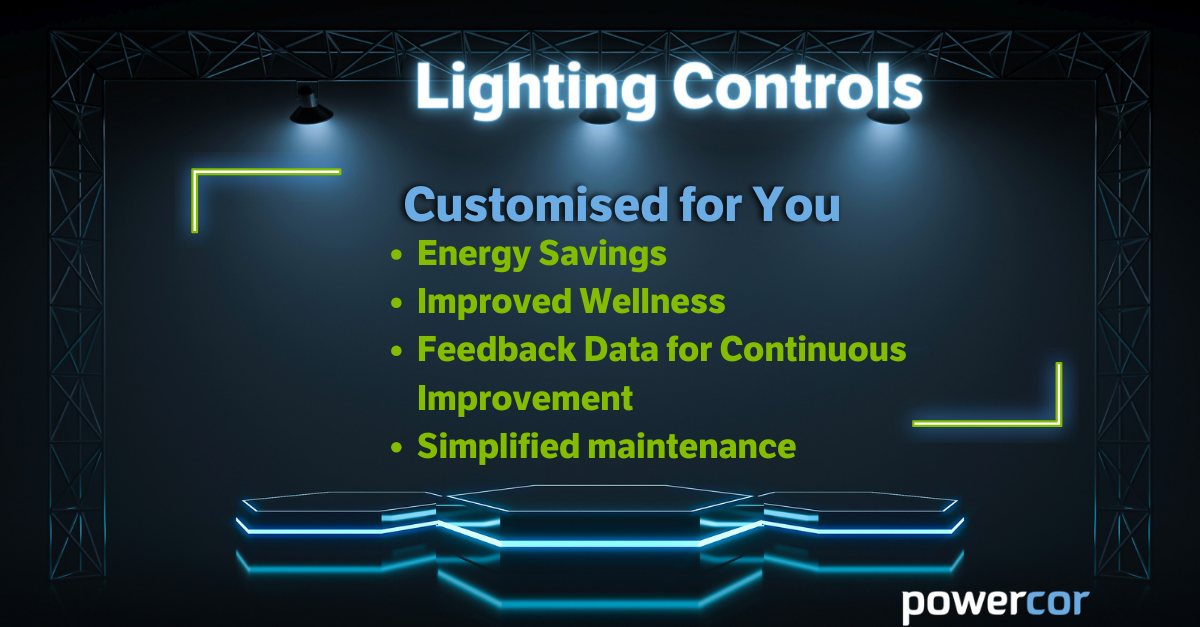Lighting controls are increasingly integral to modern LED lighting solutions as new building are erected or existing refurbished. Lighting controls enable extensive lighting customisation and help to create an energy efficiency environment. But what are lighting controls and how do they help to improve working environments? This article delves into the significance of lighting controls, their advantages, and the latest advancements in this technology.
What are Lighting Controls?
Lighting controls are devices that enable end users to tailor their lighting experience to their specific needs. Customisation is achieved through various means such as scene plates, touchscreens, sensors and switches. These controls are essential to the effective management of the energy efficiency and operational dynamics of lighting installations in diverse environments like boardrooms, open-plan offices, football stadiums, and building exteriors.
Why use Lighting Controls?
Lighting controls create a number of advantages for customers and Powercor customers are already experiencing significant benefit.
Energy saving and efficiency
Lighting controls can have a significant effect on energy usage and conservation. By ensuring that lights are only active when necessary by using motion sensors, energy wastage reduces. In addition, daylight harvesting technologies allow lights to adjust or turn off based on occupancy or natural light availability, further optimising energy use and reducing wastage.
Extensive customisation options
Lighting controls offer the opportunity to customise lighting configurations within environments. Each setting, whether it’s a corporate office or a sports stadium, has unique lighting needs and control systems can be tailored to meet their specific requirements, enhancing both aesthetics and functionality.
Workforce health and wellness
Modern lighting controls can enhance human conditions by incorporating daylight linking and circadian rhythm programming. This means lights can change not just in intensity but also in colour temperature and positively impact human health in the process; including alertness, productivity, mood, cognitive processing, and sleep quality.
A study into the effect of lighting on wellness published in the US-based National Library of Medicine concluded that:
“The findings of this study indicated that the use of natural light in the workplace could increase the illuminance and color temperature of light in the workplace and improve alertness, visual comfort, satisfaction and worker’s preference.”
Usability metrics and data
Lighting control systems are heavily metrics and data based and as such, provide valuable insights into energy usage and building operations. Sophisticated software can track heat mapping and identify less popular areas that may have the potential for alternative and more efficient use. Additionally, the system can rapidly identify and notify faults, leading to quicker repairs and minimised downtime.
Automating and improving EM testing
Testing and maintaining emergency lighting systems can be a time-consuming process, often requiring on-site visits that increase carbon footprints. Lighting control systems simplify this maintenance requirement by enabling scheduled automatic tests, eliminating the need for manual interventions. This functionality ensures compliance with safety standards while also providing quick diagnostics and repair capabilities.
What Lighting Control protocols does Powercor specialise in?
Powercor has many years of expertise supporting clients llooking to onboard the very latest in lighting control technology. We currently specialise in the following protocols:
- Dynalite
- Lightmaster
- LMM
- LM100
- DL2
- Mapview
- Pharos
- Nicolaudie
- Organic Response
- MasterConnect
- Casambi
- Hytronik
What are the latest trends and developments in Lighting Controls?
At Powercor, we believe that lighting control systems are at the beginning of their technological journey. Below are just some of the areas that will affect how this technology develops into the future.
LED lighting is at the forefront of energy-efficient lighting solutions, and central to lighting control systems. They use up to 90% less energy than traditional incandescent lights and have a lifespan of 50,000 to 100,000 hours, significantly longer than conventional bulbs. Modern LEDs can support a range of colours and white light, allowing for highly customisable lighting solutions. As LED technology improves, lighting control systems will become more robust and expansive.
In 2023, the most significant trend in this space was the adoption of wireless and IoT-enabled systems. These technologies offer flexibility, scalability, and enhanced energy efficiency. Wireless controls facilitate easy installation and centralised control, especially beneficial for large or complex systems.
The integration of data analytics and AI in lighting systems is increasing and this is an exciting development. These technologies help to optimise lighting systems, reduce energy consumption, and provide insights into occupant behaviour, making the retrofitting process simple and cost-effective. AI is rapidly developing and will have a significant effect on this technology in the years to come.
Advanced smart and automated control solutions feature scheduling, occupancy sensing, plug load controls, demand response, and daylight harvesting are contributing to efficiency and reduced energy costs. The integration of sensors, wireless communication, and digital controls enables more effective remote monitoring and management of office and other spaces.
There is a growing emphasis on human-centric lighting, which aligns with the natural 24-hour daylight cycle. Advanced controls offering colour tuning capabilities adjust colour temperature and intensity to replicate natural daylight, enhancing well-being, productivity, and mood.
Lighting controls are increasingly being integrated with Building Management Systems (BMS), offering centralised management of all building systems. This integration optimises energy consumption and enhances occupant comfort and productivity.
Sustainability is a key driver in lighting design. Biophilic design, emphasising a connection to nature, is influencing lighting solutions to mimic natural light, patterns, and colours, creating a more comfortable atmosphere for occupants and reducing environmental impact.
Lighting controls are revolutionising how we interact with and benefit from artificial lighting. By offering energy savings, customisation, health optimisation, and peace of mind, they have become a critical component in modern lighting systems. The latest trends are shaping the future of lighting controls, and these will only increase in an exciting way over the coming years. These advancements ensure that lighting control systems not only meet current needs but also adapt to future demands, offering efficient, sustainable, and user-centric lighting solutions.







